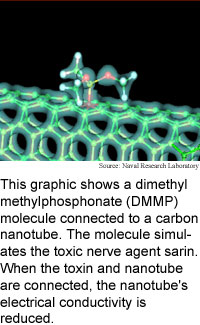
Nanotubes detect nerve gas
Naval Research Laboratory researchers have found that carbon nanotubes are sensitive to extremely small concentrations -- less than one part per billion -- of chemical nerve agents.
Carbon nanotubes are rolled-up sheets of carbon atoms that can be as narrow as one nanometer, or one millionth of a millimeter.
The researchers worked out a simple procedure to fabricate nanotube-based sensors from random networks of single-walled carbon nanotubes and used a prototype to detect dimethyl methylphosphonate, which simulates the nerve agent sarin. The networks of nanotubes form transistors; the presence of a nerve agent increases the nanotubes' resistance to electricity.
The sensors are very inexpensive, require very little power, and could be used to detect sub-parts-per-billion concentrations of nerve agents, other chemical welfare agents, and other toxic chemicals, according to the researchers. They made a prototype sensor contained in a quartz tube one-eighth of an inch wide by two inches long.
The researchers also showed that the nanotube network sensors can be combined with filters coated with polymers that are sensitive to certain chemicals to make sensors that detect specific chemicals.
Arrays of the sensors could be incorporated into handheld or remotely-operated
devices designed to detect a variety of substances, according to the researchers.
Carbon nanotube sensors could become practical within two to five
years, according to the researchers. The work appeared in the November
10, 2003 issue of Applied Physics Letters.
Biochip puts it all together
DNA assembles nanotube transistor
Software paraphrases sentences
Chaotic lasers lock messages
Briefs:
Nanotubes detect nerve gas
Microneedles give painless shots
Layers promise cheap storage
Molecule makes two-step switch
Spin material handles heat
Carbon boosts plastic circuits

Research Watch blog
View from the High Ground Q&A
How It Works
RSS Feeds:
News
Ad links:
Buy an ad link
Ad links: Clear History
Buy an ad link
|
TRN
Newswire and Headline Feeds for Web sites
|
© Copyright Technology Research News, LLC 2000-2010. All rights reserved.